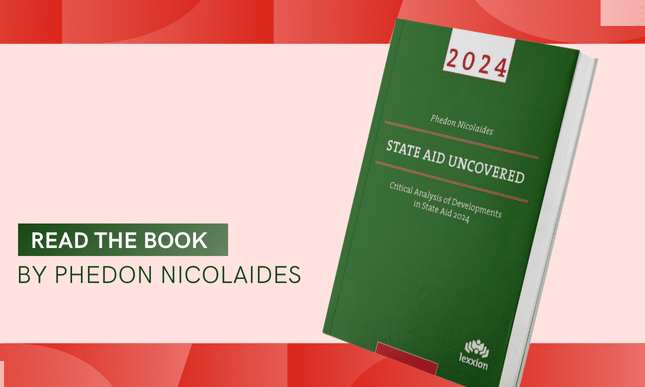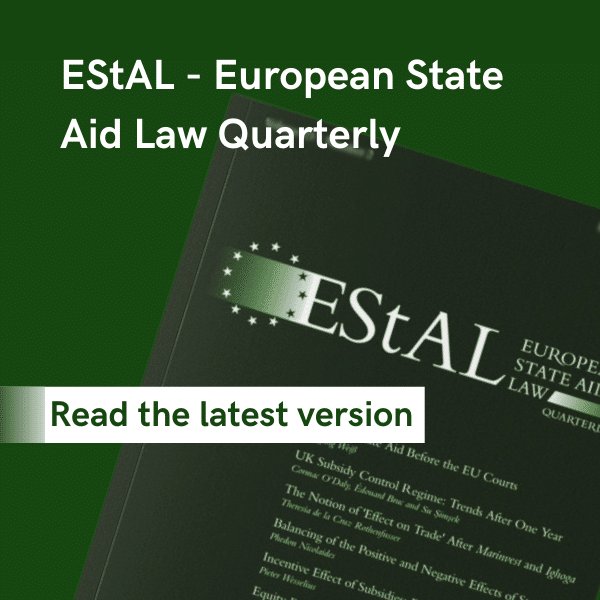
The resources of a public undertaking necessarily count as “state resources”, regardless of the degree of autonomy of the public undertaking.
However, not every decision of a public undertaking can necessarily be “imputed” to the state.
A prudent investor may take into account authorised State aid.
A prudent investor may tolerate short-term losses if it can realise sufficient profits in the longer term.
Introduction
Normally, when an investor puts money in a company, it does so on the expectation that it will make the company more profitable and, as a consequence, the company will share part or all of the extra profit with the investor. In the case which is reviewed here, rather unusually, two Member States, Denmark and Sweden, injected capital in PostNord, a postal operator owned jointly by them, to prevent the downgrading of its credit rating that could raise its cost of capital. A lower credit rating would make PostNord more risky to banks which would charge a higher rate of interest. Therefore, the cost of debt would increase for PostNord. The higher cost of debt would then reduce the profit that PostNord would be able to deliver to its two shareholders.
The case began with a complaint that was lodged at the European Commission. Consequently, the Commission examined several measures that allegedly granted State aid to Post Danmark, a subsidiary of PostNord. Some of those measures were assessed in 2018 in Commission decision SA.47707. In a separate decision, with number 2022/459, the Commission assessed the following three measures:
- A capital injection from PostNord Group into Post Danmark [DKK 2.3 billion].
- A capital injection from Denmark into PostNord [SEK 267 million].
- A capital injection from Sweden into PostNord [SEK 400 million].
This article reviews decision 2022/459.[1]
Post Danmark is a limited liability company which is 100% owned by PostNord Group. PostNord Group is 100% owned by PostNord which, in turn, is owned by Denmark [40%] and Sweden [60%].
[1] The full text of the decision can be accessed at:
The purpose of the measures in question was to enable Post Danmark and PostNord to adjust to the rapid “digitisation” of the Nordic societies. The shift to a more digital economy has resulted in a rapid decline of postal services. Apparently, the volume of postal items handled by Post Danmark has declined by 80% in the past 15 years. This significant contraction in the postal market endangered the financial viability of Post Danmark.
Denmark and Sweden claimed that they acted as private investors and that no advantage was conferred to Post Danmark or PostNord.
Existence of State aid
The first issue that the Commission had to clarify was whether the three capital injections constituted a single measure. This is because they differed in timing and because the investors and the recipients were different too.
For the following reasons, the Commission concluded that they were three different measures.
Different investors: “(156) PostNord Group, Denmark and Sweden are not the same investor. The logic and the decisional process for carrying out the capital injections are different for each of the investors concerned”.
Different beneficiaries: “(158) All three capital injections do not have the same beneficiaries. PostNord Group’s capital injection was paid to Post Danmark, while the capital injections from Denmark and Sweden were paid to PostNord AB.” In paragraphs 160-16, the Commission explained that the capital injections were not made on condition that they were channelled to Post Danmark.
Different purpose:
“(165) It is undisputed that the PostNord Group capital injection has the explicit purpose of permitting Post Danmark to implement its transformation plan.” “(166) The capital injections from Denmark and Sweden are paid to PostNord AB, and benefit the whole Group.”
The Commission also examined in considerable detail conflicting arguments concerning the date of the granting of the capital. Those arguments are not reviewed here.
Measure 1: Capital injection by PostNord Group into Post Danmark
With respect to the first measure, there were two decisive elements in the Commission’s assessment: whether the measure was imputed to the state and whether it conferred an advantage to Post Danmark.
Transfer of state resources and imputation to the state
With respect to the transfer of state resources, the resources of public undertakings are also considered to belong to the state because the state can in principle exercise control over the undertakings that it owns. “(204) It is irrelevant whether an institution within the public sector is autonomous or not”.
With respect to imputation to the state, the question that arises is whether the state was actually involved in the decision approving the measure. In this respect, the Commission found that “(206) since the PostNord Group capital injection has been agreed upon in principle by the two States […], and that such agreement has never been put into question by the two States, the Commission considers that the PostNord Group capital injection is a consequence of that agreement and is therefore imputable to the Danish and Swedish States. Moreover, this conclusion is reinforced by the implementing agreement (see recital (25)), in which Denmark and PostNord AB explicitly agree on the granting of the Group capital injection.”
Presence of advantage
The Commission accepted that, methodologically, it was correct to assess the economic rationality of the capital injection by considering the discounted cash flow [DCF] and the expected net present value [NPV].
“(212) The Commission considers that the profitability forecasts used in the DCF models are reasonable and justified by market studies (see recital (122)). In particular, the assumptions on the growth rates of revenues and the profitability of Post Danmark were benchmarked against a sample of Post Danmark’s peers (see recital (122)). That sample included a number of publicly listed companies in the postal services and logistics sectors. For each of Post Danmark’s peer companies, the market analyst forecasts of revenues and profits were retrieved. Overall, that benchmarking exercise revealed that, in comparison to the market analyst forecasts, the forecasts underpinning Post Danmark’s business plan appeared conservative.”
“(213) According to the business plan, the profitability of Post Danmark in the initial years following the PostNord Group injection would be negative. […] While the substantial restructuring costs incurred in the years immediately after the Post Nord Group injection do lead to losses, the expected profitability after the turnaround of Post Danmark would be sufficient, from an ex-ante perspective, to consider that PostNord Group injection is in line with the market conditions.”
“(214) The profitability analysis, using the free cash flow to equity approach […] revealed that, as a shareholder of Post Danmark, PostNord Group expected a return higher than the cost of the equity injection.”
“(215) Furthermore, the ex-ante expected profitability of the Post Nord Group injection derived from the accurate determination and justification of the WACC and cost of equity, which were used to discount the free cash flows to the firm and to shareholders, respectively. […] those discount rates adequately reflected the risk level of Post Danmark’s cash flows. The WACC notably took account relevant risk premiums (see recital (148)).”
“(216) With regard to ITD’s argument that the DCF analysis report has been conducted by PostNord itself and not by an independent expert, the Commission notes that State aid rules do not require that the assessment reports is to be conducted by an expert that is independent from the beneficiary entities. State aid rules only require that the market conformity analysis itself is to be established on the basis of a generally accepted, standard assessment methodology, based on available objective, verifiable and reliable data, which should be sufficiently detailed and should reflect the economic situation at the time at which the transaction was decided, taking into account the level of risk and future expectations.”
In this connection, it should be noted that several pages later on in the decision, in footnote 102, the Commission made the following clarification: “The level of sophistication of such an ex-ante assessment may vary depending on the complexity of the transaction concerned and the value of the assets, goods or services involved. Normally, such ex-ante evaluations should be carried out with the support of experts with appropriate skills and experience. Such evaluations should always be based on objective criteria and should not be affected by policy considerations. Evaluations conducted by independent experts may provide an additional corroboration for the credibility of the assessment.”
So, while it is true that the case law does not require that ex ante financial calculations are carried by independent experts, it is always wise of Member States to make use of their services before they submit any reports to the Commission.
Next, the Commission evaluated several arguments put forth by a complainant according to which PostNord Group exaggerated the costs it would incur had the capital injection not been made. By contrast, the Commission found those costs to be eligible because they would have been borne, even indirectly by PostNord Group, in case Post Danmark went bankrupt.
“(220) With regard to ITD’s argument that the DCF analysis includes ineligible cash flows, such as the USO compensation, the Commission notes that since the USO compensation is regarded as a compatible aid, it is eligible to the DCF analysis. Indeed, a prudent investor would factor in compatible aid in its assessment of the relevance of an investment.”
“(221) With regard to ITD’s claim that even if direct and indirect costs of Post Danmark’s bankruptcy scenario were to be included in the DCF analysis, only a part of those costs and not the entire amount should have been included, since Post Danmark’s bankruptcy would not necessarily be avoided through the grant of PostNord Group’s capital injection, the Commission notes on the contrary that the calculations submitted by Denmark and Sweden demonstrated that the group’s capital injection would prevent Post Danmark’s bankruptcy, which was also actually prevented.”
“(224) With regard to ITDs’ claim that WACC in the DCF is too low, since it took into account PostNord Group’s peers, rather than Post Danmark’s peers, […], the Commission reiterates its assessment in recital (215) and notes that the DCF analysis took into account Post Danmark’s peers benchmarks while the top up premiums reflected appropriately the relevant risks for the calculation of the WACC.”
“(228) In conclusion, based on the two quantitative profitability analyses that Denmark and Sweden have submitted, the Commission concludes that the PostNord Group capital injection is in line with market conditions, as those analyses demonstrated that a private investor in the position of PostNord Group would also have injected capital into Post Danmark.”
Measure 2: Capital injection from Denmark into PostNord
The decisive element with respect to the Commission’s assessment of possible existence of State aid was the presence of advantage.
The Commission began its analysis by observing that “the Danish (or Swedish) authorities have still not demonstrated convincingly that PostNord AB’s credit rating would deteriorate in the absence of the capital injections from Denmark and Sweden. As an unlisted company, PostNord AB does not formally have a credit rating, and a financial institution could be expected to take into account more factors than PostNord AB’s net debt/EBITDA ratio to determine PostNord AB’s credit rating. The assumption that a financial institution would necessarily have imposed significantly stricter financing conditions only because that ratio would increase temporarily into undesirable territory in the absence of the capital injections from Denmark and Sweden has not been substantiated sufficiently”.
“(241) Moreover, while the analysis presented by, Rothschild, shows that PostNord AB’s credit rating would deteriorate into non-investment grade territory only for 2019 to 2020, the DCF model used to quantify this impact on the enterprise value has incorporated a higher WACC of […] % in perpetuity as confirmed by the Danish state in their response to questions of the Commission. Such approach leads to an impact of the capital injection on the enterprise value greater than SEK 1 billion and, therefore also greater than State’s capital injection of SEK 667 million”.
“(242) Using the normal WACC of […] % for the terminal value in the calculation submitted by the States would lead to the conclusion that the investment is not compliant with the market economy operator principle contrary to the conclusion of the States, which was reached based on a permanently degraded WACC of […] %.” “(243) The adjusted calculation (using the normal WACC), based on the free cash flow of Denmark and Sweden’s DCF analysis […] illustrates that the capital injections of Denmark and Sweden of SEK 667 million increase PostNord AB’s enterprise value by only SEK 62 million, which is less than the amount of that capital injections.”
“(244) That adjusted calculation shows that contrary to what is argued by the States, the increase in the enterprise value attributable to capital injections from Denmark and Sweden would not exceed SEK 62 million so much below the SEK 667 million investment. The gain in financing cost is much lower than expected by the States because the deterioration of financing conditions, if it happens, would only have temporary effects.”
The calculations outlined in paragraphs 242-244 are complex, so perhaps a simple numerical example may help the reader. Assume that the cost of debt of PostNord is 5 and the net result before interest at the end of the operating year is 9. This means that the net result after interest is paid is 4. Now assume that as a result of the downgrading of the credit rating, the cost of debt jumps to 10. Profit of 9 before interest is not enough. PostNord will make a loss of 1. However, if by injecting, say, extra capital of 3, the two shareholders succeed to restore the credit rating of PostNord to its previous level, the cost of debt will decrease to 5. That will leave 4 to remunerate the extra capital and cover a risk margin of up to 33% [i.e. 3 + (3×0.33) = 4]. By contrast, if the return of the credit rating to its lower level would require a capital injection of, say 6, then the two shareholders should have preferred to let PostNord to go bankrupt because, even if they would have to pay for all its liabilities, a loss of 1 is better than a loss of 2 [= 9 – 5 – 6].
At any rate, the Commission rejected the calculations submitted by the two Member States for two reasons. First, they did not prove that the downgrading of PostNord would be permanent and, second, the calculations with the lower WACC showed that the value of PostNord would increase much less than the amount of capital injected.
Then the Commission addressed the arguments put forth by the two Member States to justify their capital injections.
“(245) As to the argument raised by the States that the burden of proof required by the Commission is allegedly excessive, it should be noted that according to State aid rules and Commission’s practice, the burden of proof always lies with the Member State.”
“(246) The Commission considers that the Danish authorities failed to demonstrate that it is credible that PostNord AB would have lost shadow investment grade rating in the absence of the capital injections from Denmark and Sweden and would have kept it with the capital injections from Denmark and Sweden. Moreover, the Danish authorities also failed to demonstrate that the financial consequences of that loss of investment grade, assuming it would happen, would exceed the amount of their capital injection. A rational market economy operator would not have carried out the capital injection in the absence of such analysis showing that the operation is profitable or that there are economic advantages of this operation.”
Measure 3: Capital injection from Sweden into PostNord AB
With respect to measure 3, the analysis of the Commission is limited to a single paragraph because the reasoning is exactly the same as for measure 2. “(253) For the same reasons as those set out in recitals (240) to (247) […], Denmark and Sweden failed to substantiate or to quantify the risk of PostNord AB losing its shadow investment grade absent the capital injection from Denmark and Sweden before and after the opening decision. The likelihood of losing investment grade is not prima facie obvious and the estimation of the consequences of such loss are problematic both from a theoretical viewpoint (namely permanent degradation of the cost of debt) as well as a quantitative viewpoint (calculation of the enterprise value).”
In view of the above, the capital injections by Denmark and Sweden were found to constitute State aid.
Conclusion
Since Denmark and Sweden did not invoke any arguments concerning the compatibility of the aid with the internal market [Post Danmark already received State aid in the form of compensation for the universal postal services it provided], the Commission ordered the recovery of SEK 667 million from PostNord.
[1] The full text of the decision can be accessed at:



